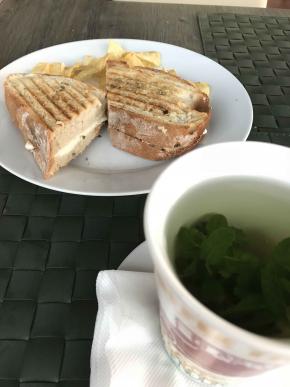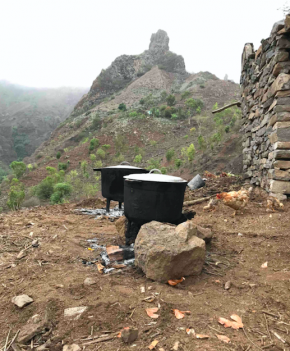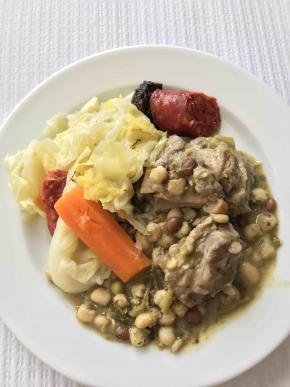Why the sandwich will not take over Cape Verde
The sandwich is a wild success, so much so that it is said to have consumed Britain (Knight 2017). This is good news for businesses. It also reflects important eating habit trends. After learning about the situation in Britain, one is compelled to look farther for comparison. In Cape Verde, the sandwich is not making significant inroads. It continues to be foreign, prepared fresh and appreciated by tourists and in a restricted circle of young middle-class professionals. This must be understood within the social and economic context. The following discusses whether or not the sandwich stands a chance in the Atlantic. It looks at the history and current development of Cape Verde, focuses on food issues, and explores how the sandwich fits in.
Food is dear to Cape Verde. People who grew up in the last century revere food. Memories of food shortages continue to haunt them and determine their attitude towards food. Famine is the keyword. For centuries, colonial Cape Verde struggled with extremely harsh living conditions (Carreira 1984, 1977; Bigman 1993). One solution was to leave. So many people emigrated that currently there are more Cape Verdean descendants living abroad than on the archipelago. The United States and Portugal host the two biggest Cape Verdean diasporas (see, for example, Gibau 2005; Batalha 2004). After 1975, a well-educated cadre seized the opportunity to change Cape Verde. Extreme poverty was eliminated. With time, Cape Verde graduated to a lower-middle-income country. At one time, it was dubbed the African Success Story (African Development Bank 2012). It was one of the rare African countries to have achieved all the Millennium Goals. Cape Verde is a highly functional democracy, and some consider it even better than that of its former colonizer, Portugal. As such, the general outlook is bright. The present generation no longer experiences dire food shortages, but they are obliged to learn about those times in textbooks as part of the country’s history and culture. All this makes clear that food marked Cape Verde and its people. Food is not something to be taken lightly. Food tells hidden stories of sacrifices, struggles and sufferings (Rodrigues 2008).
 Photo 1In Cape Verdean cities, one can certainly order a sandwich. For instance, good sandwiches are made in Mindelo, São Vicente. This is the island that prides itself on its bakeries and medium-scale factories that churn out good bread, biscuits and buns. For a more local selection, order sandes com queijo de terra (sandwich with local cheese, as seen in Photo 1, from a restaurant located on the main esplanade of the city), or sandes com linguiça (sandwich with salted meat). It should be highlighted that places making sandwiches are often touristic. They are visited frequently by white European travellers. Sitting at the next table are probably young Cape Verdean professionals and their families or friends that resemble an emerging African middle class (concerning African Middle Class, refer to Melber 2016; Lentz 2015; Darbon and Toulabor 2013). What is certain is that the sandwich is not part of the everyday foodscape of Cape Verde.
Photo 1In Cape Verdean cities, one can certainly order a sandwich. For instance, good sandwiches are made in Mindelo, São Vicente. This is the island that prides itself on its bakeries and medium-scale factories that churn out good bread, biscuits and buns. For a more local selection, order sandes com queijo de terra (sandwich with local cheese, as seen in Photo 1, from a restaurant located on the main esplanade of the city), or sandes com linguiça (sandwich with salted meat). It should be highlighted that places making sandwiches are often touristic. They are visited frequently by white European travellers. Sitting at the next table are probably young Cape Verdean professionals and their families or friends that resemble an emerging African middle class (concerning African Middle Class, refer to Melber 2016; Lentz 2015; Darbon and Toulabor 2013). What is certain is that the sandwich is not part of the everyday foodscape of Cape Verde.
Most Cape Verdeans are not used to consuming food away from home. Some universities and institutes do not have a canteen because students and staff walk home to eat. Besides the proximity, costs are also important. Eating out is a treat, precious in cities and largely non-existent in rural areas. According to local Airbnb hosts in Ponta da Água, Santo Antão, restaurants opened around a decade ago to promote tourism and up to this day inhabitants in the area are irregular clients in these foreign-oriented dining outlets. Even when locals are in daily contact with foreigners, they are slow to adopt foreign ways. A typical family prepares a stew for two hot dishes during the day. A traditional corn-based diet has been largely replaced by imported rice. Women take what they can from the farm, go to the market, buy from street vendors, use food parcels from emigrants and purchase what they lack in grocery stores. Sandwiches look awkward in the background. Since they are prepared, they have to be sold for a higher price. If served fresh, they are even costlier. If sandwiches are packaged, they require refrigerating and this weighs on the electricity bills of the transport van and of the store in such a warm country as Cape Verde. Anything that comes with packaging is costly in Cape Verde because it tends to be foreign or imported.
An additional problem for the sandwich enthusiast to overcome is the quantity. In Praia, Santiago, women are seen eating from basins in the municipal market. For others, a dish with rice, beans, fish or meat goes for two prices, depending on the quantity.
 Photo 2Cape Verdeans generally desire generous servings, saying that they do not like little food (não gostar de pouca comida). In households with a lot of children, there may not be a fixed hour for meals; food is served constantly from large pots (see Photo 2, which is from my fieldwork in the interior of Santiago). Considering this, the sandwich is not at all appealing to the female family head (for more on Cape Verdean family structures, read Åkesson 2004; Åkesson, Carling, and Drotbohm 2012; Silva and Fortes 2011; Martins and Fortes 2008). It is not practical for a grandmother with a dozen mouths to feed, nor for the single-mother, unemployed, or surviving on a minimum salary worth 130 euros.
Photo 2Cape Verdeans generally desire generous servings, saying that they do not like little food (não gostar de pouca comida). In households with a lot of children, there may not be a fixed hour for meals; food is served constantly from large pots (see Photo 2, which is from my fieldwork in the interior of Santiago). Considering this, the sandwich is not at all appealing to the female family head (for more on Cape Verdean family structures, read Åkesson 2004; Åkesson, Carling, and Drotbohm 2012; Silva and Fortes 2011; Martins and Fortes 2008). It is not practical for a grandmother with a dozen mouths to feed, nor for the single-mother, unemployed, or surviving on a minimum salary worth 130 euros.
In terms of logistics, the sandwich cannot be produced locally on a large-scale. There is a low reliability of ingredients. The prices of local vegetables and fish vary according to the severity of the dry seasons. There is no McDonald’s in Cape Verde and in most African countries because of these challenges (Mail & Guardian 2015). Dependability is an issue. In Cape Verde, imported produce, frozen chicken and pork are common sights. They are necessary because the country does not produce enough to meet national demand. Also, imported alternatives are cheaper, especially if they come from South America and Asia. A daring entrepreneur might have to resort to foreign ingredients to put together a sandwich. Economy of scale is out of the question.
Amid this grim depiction, the sandwich maker can learn a lesson from katxupa, now considered the national dish of Cape Verde (A Semana 2013; Appadurai 1988; Cusack 2000). Katxupa was originally made from corns, beans, salt and water. Fresh fish or salted pork were used very stringently to season it. Katxupa was eaten at night with broth and in the morning when it is stickier and more fulfilling. That was the solution to feed people with what the land produced in old times, especially on agricultural islands like Santiago and Santo Antão where people laboured on farms. This traditional dish is consumed increasingly sparsely because of the change of cooking method. Instead of wood, families have adapted to gas, which is convenient but expensive. Boiling hours are long, especially without a pressure cooker. Women with double burdens have limited time. Therefore, the closer to cities people live and the more familiar they are with the urban lifestyle, the less often they prepare katxupa. Furthermore, Katxupa has been updated and changed so much that katxupa rika is used to distinguish the more elaborated, extravagant and meaty recipe, especially in classy restaurants in touristic areas and among migrants the diasporas (see Photo 3, taken at a Cape Verdean culture gathering in Greater Lisbon).
 Photo 3Still, katxupa is arguably the only prepared food that is sold and/or consumed on the go. Construction workers eat katxupa in a makeshift luncheonette before resuming work and getting sweaty. Taxi drivers pick up a box of katuxpa from a café on the way. Like most African countries, Cape Verdeans have yet to nurture pride in their culinary art, but they do present katxupa to the world as something they can identify with and consider delicious.
Photo 3Still, katxupa is arguably the only prepared food that is sold and/or consumed on the go. Construction workers eat katxupa in a makeshift luncheonette before resuming work and getting sweaty. Taxi drivers pick up a box of katuxpa from a café on the way. Like most African countries, Cape Verdeans have yet to nurture pride in their culinary art, but they do present katxupa to the world as something they can identify with and consider delicious.
There are implications for the sandwich. While katxupa was born as a local solution for local problem and then developed recipes for national identity construction, the sandwich is an import and has yet to identity itself with a certain group or lifestyle within the reach of Cape Verdeans. In a way, katxupa is practical while sandwich is more aesthetic. This does not necessarily translate into a disadvantage. In Mindelo, katxupa is perhaps not as highly recommended as it is in rural areas or on other islands. For urban dwellers in a mini-cosmopolitan port city such as Mindelo, katxupa rika is preferred, but this takes place on a different panorama where katxupa is deemed a weekend specialty, a true cultural luxury that is at once traditional and modern. To get a foothold in Cape Verde, the sandwich has to assume an identity and align itself with particular modes of consumption. We shall see if the young, international-oriented Cape Verdean middle-class will stick to a sandwich diet long enough for it to take root, knowing that they are also a group conscious of their cultural heritage and the benefits of a traditional diet (Kuo 2015; Radiotelevisão Caboverdiana 2017). Mindelo, which does not produce its own food, is highly acceptive of imports and foreign people, products and ideas. Sandwich stands a better chance there.
At the end of the day, we are reminded that the sandwich thrives in Britain, which is culturally very different from Cape Verde. The latter is a much more collective society. Everything is shared, including food. The sandwich is not normally made for sharing. Additionally, Cape Verde is a hot-food culture. The sandwich has yet to transform itself from an originally chilled bun with fillings into a heart-warming meal. Until then, we content ourselves with sandwiches in Britain and elsewhere, but not in Cape Verde.
References
A Semana. 2013. “Nos Ku Nos: Cachupa Com Potencial Para Património Da Culinária Mundial [We with Us: Cachupa Has Potential to be World Culinary Heritage].” http://www.asemana.publ.cv/?Cachupa-com-potencial-para-patrimonio-da-cul....
African Development Bank. 2012. “Cape Verde: A Sucess Story.” https://www.afdb.org/fileadmin/uploads/afdb/Documents/Project-and-Operat... Verde - A Success Story.pdf.
Åkesson, Lisa. 2004. Making a Life: Meanings of Migration in Cape Verde. Goteborg: Department of Social Anthropology, Goteborg University.
Åkesson, Lisa, Jørgen Carling, and Heike Drotbohm. 2012. “Mobility, Moralities and Motherhood: Navigating the Contingencies of Cape Verdean Lives.” Journal of Ethnic and Migration Studies 38 (2): 237–60.
Appadurai, Arjun. 1988. “How to Make a National Cuisine: Cookbooks in Contemporary India.” Comparative Studies in Society and History 30 (01): 3.
Batalha, Luís. 2004. The Cape Verdean Diaspora in Portugal: Colonial Subjects in a Postcolonial World. Lanham: Lexington Books.
Bigman, Laura. 1993. History and Hunger in West Africa: Food Production and Entitlement in Guinea-Bissau and Cape Verde. Westport: Greenwood Press.
Carreira, António. 1977. Cabo Verde: Classes Sociais, Estrutura Familiar, Migrações [Cape Verde: Social Classes, Family Structure, Migrations. Lisbon: Ulmeiro.
———. 1984. Cabo Verde: Aspectos Sociais. Secas e Fomes Do Século XX [Cape Verde: Social Aspects. Droughts and Famines in the 20th Century]. 2nd ed. Lisbon: Ulmeiro.
Cusack, Igor. 2000. “African Cuisines: Recipes for Nation-Building?” Journal of African Cultural Studies 13 (2): 207–25.
Darbon, Dominique, and Comi Toulabor. 2013. “What Middle Class(es) in Africa? A Literature Review.” Paris: Agence française de développement. Working Document 118.
Gibau, Gina. 2005. “Contested Identities: Narratives of Race and Ethnicity in the Cape Verdean Diaspora.” Identities 12 (3): 405–38.
Knight, Sam. 2017. “How the Sandwich Consumed Britain.” The Guardian, November 24. https://www.theguardian.com/news/2017/nov/24/how-the-sandwich-consumed-b....
Kuo, Lily. 2015. “West Africans Have Some of the Healthiest Diets in the World.” Quartz Africa, August 6. https://qz.com/africa/473598/west-africans-have-some-of-the-healthiest-d....
Lentz, Carola. 2015. “Elites or Middle Classes? Lessons from Transnational Research for the Study of Social Stratification in Africa.” 161. AP IFEAS 161/2015. Mainz.
Mail & Guardian. 2015. “No McLove for Africa: Why the Whole Continent Has Fewer McDonalds than New York City Alone,” June 17. http://mgafrica.com/article/2015-06-17-mcdonalds-no-mclove-for-africa.
Martins, Filipe, and Celeste Fortes. 2008. “Para Além Da Crise. Jovens, Mulheres e Relações Familiares Em Cabo Verde [Beyond Crisis. Youth, Women and Family Relations in Cape Verde].” (Con)Textos: Revista d’antropologia i Investigació Social 5. Departament d’Antropologia Cultural i Història d’Amèrica i Àfrica de la Universitat de Barcelona: 15–29.
Melber, Henning. 2016. The Rise of Africa’s Middle Class: Myths, Realities and Critical Engagements. London: Zed Books.
Radiotelevisão Caboverdiana. 2017. “Cabo Verde é o Terceiro País Do Mundo Que Consome Mais Comida Saudável [Cape Verde Is the Third Country in the World That Consumes the Most Healthy Food],” January 21. http://www.rtc.cv/index.php?paginas=47&id_cod=54882.
Rodrigues, Isabel Fêo. 2008. “From Silence to Silence: The Hidden Story of a Beef Stew in Cape Verde.” Anthropological Quarterly 81 (2): 343–76.
Silva, Carmelita, and Celeste Fortes, eds. 2011. As Mulheres Em Cabo Verde: Experiências e Perpectivas [Women in Cape Verde: Experiences and Perspectives]. Praia: Universidade de Cabo Verde.